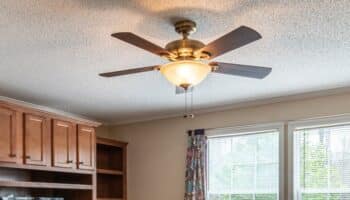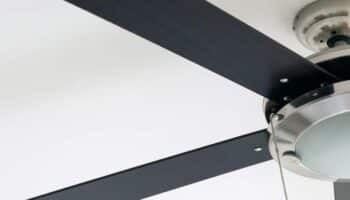Is your ceiling fan running slowly? Adding some lubrication could do the trick.
Can you imagine a world without ceiling fans? A world where air circulation inside a room and proper ventilation were exclusive to AC units?
Given how versatile and relatively cheap ceiling fans are compared to other cooling alternatives – it doesn’t make sense not to own one.
However, having a ceiling fan running slowly is just as bad as not having one at all. The blades are spinning, but the air generated is negligible.
What gives?
There are several reasons why you’re experiencing the issue. And if you’ve already tried giving your fan a pep talk to raise its spirits, chances are the problem lies with improper balancing or a lack of lubrication.
Below, you’ll find a list of the most common causes behind a ceiling fan running slow and 6 simple steps you can take to address them.
Ready? Let’s dive in!
Fixing a Slow Ceiling Fan
When your ceiling fan is running slow, pinpointing the source of the problem is key.
Something as simple as forgetting to clean the bearing occasionally could be making your fan speed slow. Before thinking about something being broken inside the fan, we must analyze every external factor that can be at play.
Here are the 6 steps you can follow to speed up your ceiling fan:
- Lubricate the fan.
- Balance the blades.
- Replace the capacitor.
- Use lighter blades.
- Tighten some screws.
- Clean the bearing.
#1 Lubricate the Fan
Lubricating your ceiling fan’s bearings is key. Machines with moving parts, such as car engines, turbines, and fans, benefit greatly from being properly lubricated with oil.

A ceiling fan running slow could be trying to tell you that it’s time to put some oil on the bearing. I find that occasionally lubricating the bearing can solve your current problem and extend your ceiling fan’s lifespan significantly.
Solution: My usual advice is to be a little more conscious about how you use your fan and give it adequate maintenance at least four times a year.
#2 Balance the Blades
Balancing your ceiling fan’s blades can impact the way it works greatly.
When your ceiling fan’s blades are properly balanced, they can spin around their axis without any trouble, but when there’s even the slightest imbalance, you may experience motor failure, overheating, high electricity bills, short-circuiting, and, of course, slow blade speeds.
Solution: Look for any imbalance.
Provided that you find even the slightest degree of imbalance, I find that you can correct it by tightening the screws at the base, trimming your blades, or even adding special weights.
#3 Replace the Capacitor
The capacitor is the lifeblood of your ceiling fan. Without the capacitor, your ceiling fan will run slow, becoming nothing but some odd, static decoration that could pass off as a weird chandelier… maybe.

The capacitor is what powers your motor and allows for the fast revolutions that generate the air currents you love.
Being such an important part of your ceiling fan, any malfunction in the capacitor can be catastrophic and tricky to diagnose.
In my experience, depending on the severity of the damage to the capacitor, your ceiling fan might not even spin at all. However, if the damage is only partial, it may still function at very low speeds.
It’s critical that as soon as you suspect a fault in the capacitor to be to blame, you stop using your ceiling fan immediately, as otherwise, you risk short-circuiting and permanently damaging the appliance.
Solution: You’ll have to replace the capacitor in case of failure. To replace the capacitor, please follow the steps below.
- Carefully turn off your breakers to interrupt all electrical current to the ceiling fan.
- Remove the light bulbs and their housings.
- Undo the screws in the motor holding the outer metal panel.
- Expose your ceiling fan’s capacitor and all its other internal components.
- Test the capacitor for continuity with a multimeter if you have one.
- Replace the capacitor if necessary.
The complete process is a little more complex, but the above steps should give you a general idea. If you’re a visual person like me and want a detailed walkthrough, you can follow along step by step; there are tons of online videos you can check out.
#4 Use Lighter Blades
The weight of your blades can play an important role in explaining your ceiling fan running slowly.
While your manufacturer should have installed the right-sized blades for your ceiling fan model’s adequate functioning, there’s always room for human error.
Using blades that are too heavy for your motor can explain your current situation and put your ceiling fan at risk of overheating, short-circuiting, and general malfunction.
Solution: Read your user manual again carefully. More often than not, you’ll be able to find in there the right dimensions for the blades you should be using.
Once you know the measurements, you can carefully remove one of your ceiling fan blades and measure and weigh them. Should the blades be the incorrect size, you must replace them.
#5 Tighten the Screws
Loose screws can also explain why your ceiling fan is running slow.
Your ceiling fan is in constant motion, sometimes for hours at a time, so having screws loosen occasionally is to be expected. If your ceiling fan is running slowly, chances are one or more screws need to be tightened again.
Loose screws can cause your fan blades to spin erratically, compromising your fan’s adequate functioning and putting it at risk of sustaining permanent damage.
Solution: From what I’ve seen, tightening the screws should be fairly simple. Grab a screwdriver you find comfortable, and look for any screws on your ceiling fan’s body that need tightening.
#6 Clean the Bearing
Last but not least, you must always remember to clean your bearings.
Although ceiling fans don’t seem overly complicated, they rely greatly on physics. The high-speed spinning that provides you with the nice air current you love exerts a constant centrifugal force on your fan’s axis and bearing.
If the bearing is not properly cleaned and lubricated, your ceiling fan could start running slowly, overheat, and even catch on fire.
If none of the solutions above have worked out for you, and you suspect a dirty bearing is why your ceiling fan is running slowly, please stop using the appliance immediately, clean the bearing, and lubricate it generously.
Solution: Ideally, you want to clean your ceiling fan’s bearing every month, but if that’s not possible, at least do it every trimester.
Getting Your Ceiling Fan to Run Faster
A ceiling fan that runs slowly is like a Ferrari without petrol. It sure looks beautiful, but for all purposes, it’s useless.
I know how frustrating having your ceiling fan running slowly can be. Luckily, as I hope you’ve learned in this piece, fixing most of the issues related to the situation is simple and shouldn’t take up too much of your time.
More often than not, everything can be resolved by maintaining your ceiling fan regularly and using the right-sized blades.
Thanks for reading. If this article was useful and answered your questions, please check out our other resources below and consider subscribing to our newsletter.
Enjoy the nice, lovely current!
-Craig.







